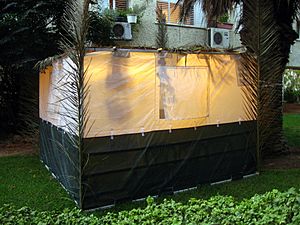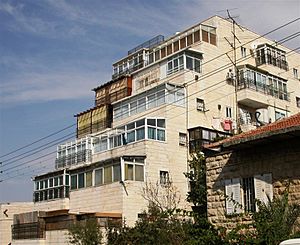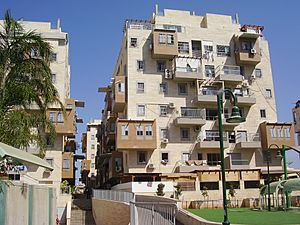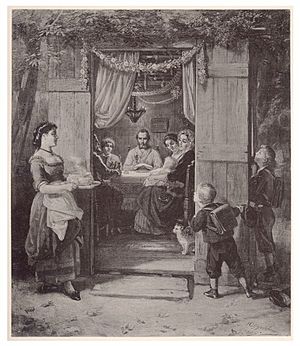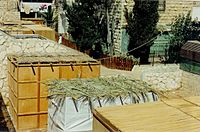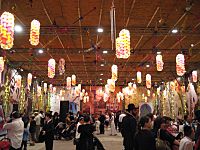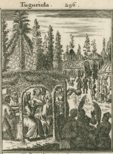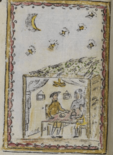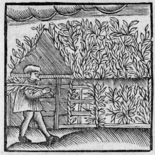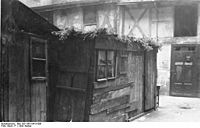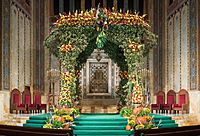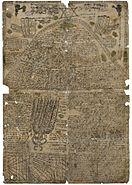Sukkah facts for kids
A sukkah (say "SOO-kah") is a special temporary hut built by Jewish people for a week-long festival called Sukkot. It's like a small, cozy shelter. The roof is made of branches, and people often decorate it with autumn themes, harvest items, or Jewish symbols.
The Bible, in the book of Leviticus, says the sukkah reminds Jewish people of the time God protected the Israelites in the desert. This was after they became free from slavery in Egypt. During Sukkot, it's common for Jewish families to eat, sleep, and spend time inside their sukkah. Sukkot is a very happy holiday, and the sukkah itself shows that life can be fragile and that people depend on God.
Contents
What People Do in a Sukkah
Jewish law says that people should eat and, traditionally, sleep in the sukkah. However, if it's too uncomfortable, like if it's very cold, people don't have to stay in it. For example, in places far north where autumn nights get chilly, many Jewish people will eat and relax in the sukkah but go inside their homes to sleep.
If it rains, you don't have to stay in the sukkah. Ancient Jewish writings compare rain on a sukkah to someone giving a drink to their master, only for the master to throw it back. This means that if it rains, it's like God is showing displeasure, and you don't have to fulfill the commandment of sitting in the sukkah.
In warmer places like Israel or Florida, many Jewish people do all their eating, studying, and sleeping in the sukkah. Some won't eat or drink anything outside of it, while others might have a drink or fruit outside.
In Israel, it's common for hotels, restaurants, and even zoos to have a kosher sukkah. This means it's built according to Jewish law, so customers can eat there during the holiday.
Some Jewish groups, like the Lubavitcher Hasidim, don't sleep in the sukkah because they believe it's too holy. But they will still eat there, even if it's raining.
A fun activity during Sukkot is "Sukkah hopping." This is when people visit each other's sukkahs. Food is often set out so visitors can say the special blessings.
How a Sukkah is Built
Jewish law has rules for building a sukkah. It needs a roof made of natural materials that are no longer attached to the ground. This special roof material is called s'chach (say "skhakh"). A sukkah must also have at least three walls. It should be at least three feet tall, and part of its roof must be open to the sky. Only the part under the open sky counts as kosher. Most rules say the floor area should be at least 16 square cubits (a cubit is an old measurement, about the length of a forearm).
The walls of a sukkah can be made from many materials, as long as they are strong enough to stand up to normal wind. If the walls are too flimsy and sway a lot in the wind, the sukkah might not be kosher. Some experts disagree on whether canvas walls are okay, but many allow them if they are well-anchored.
You can build a sukkah on the ground, on a porch, or on a balcony. Many Jewish families even design their porches to make building a sukkah easier. There are also portable sukkahs available now. These have a metal frame that folds up and cloth walls, which are great for people with small spaces or those who travel.
The Roof Covering (S'chach)
The roof covering, or s'chach, must be made of something that grew from the earth but is now cut off from it. Things like palm leaves, bamboo sticks, pine branches, or wood can be used. But they can't have been used for something else before.
There needs to be enough s'chach so that there is more shade than sun inside the sukkah. However, there should also be small gaps in the s'chach so you can see the sun or stars through it.
Decorations
Many people love to decorate their sukkahs! They hang streamers, shiny ornaments, and pictures on the walls and ceiling. Fresh, dried, or plastic fruits are popular decorations, especially the etrog (a special citrus fruit) and the seven species mentioned in the Bible that Israel is known for: wheat, barley, grapes, figs, pomegranates, olives, and dates.
Some families also line the inside walls with white sheets. This reminds them of the "Clouds of Glory" that protected the Jewish people when they wandered in the desert. However, some groups, like the Chabad, don't decorate their sukkahs because they believe the sukkah itself is already beautiful.
-
Safra Square Sukkah, Jerusalem, 2009
Special Prayers in the Sukkah
The Sukkah Blessing
When you use the sukkah, Jewish law says you should say a special blessing. This blessing is usually said after you've blessed your food, like bread or cake.
| Hebrew | Transliteration | English |
|---|---|---|
|
ברוך אתה ה' א‑לוהינו, מלך העולם, אשר קדשנו במצותיו וצונו לישב בסכה. |
Barukh ata Adonai E-loheinu, melekh ha'olam, asher kid'shanu b'mitzvotav v'tzivanu leishev ba'sukah. | Blessed are You, LORD our God, King of the universe, Who has made us holy with His commandments and commanded us to dwell in the sukkah. |
Welcoming Guests (Ushpizin)
During Sukkot, some Jewish people say a prayer called ushpizin (say "oosh-pee-ZEEN"). This prayer is a way of welcoming seven important "exalted guests" into the sukkah. These guests are famous leaders from Jewish history: Abraham, Isaac, Jacob, Moses, Aaron, Joseph, and David.
Tradition says that each night of Sukkot, a different one of these guests enters the sukkah first, followed by the other six. Each guest is connected to a special spiritual idea for that day.
Interesting Sukkah Examples
Drive-Through Sukkah
In 2010, a synagogue in Miami, Florida, called Bet Shira Congregation, set up a special drive-through sukkah in their parking lot. They even called it "McBet Shira Sukkah"! This allowed people to experience the sukkah without leaving their cars.
Sukkah City
"Sukkah City" was a cool art and architecture contest held in New York City's Union Square Park. Designers created unique sukkah designs. The winning design was built and displayed for the seven days of Sukkot in 2010.
Pedi-Sukkah
A "Pedi-Sukkah" is a sukkah that isn't stationary. It's built on the back of a mobile vehicle, usually a three-wheeled bicycle. A person named Levi Duchman introduced the Pedi-Sukkah in 2009. Since then, these mobile sukkahs have become popular in many places, allowing people to celebrate Sukkot even when they are out and about.
Samaritan Sukkahs
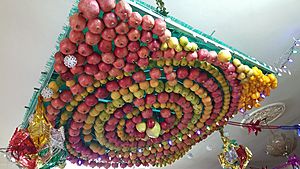
The Samaritans, another ancient group, also build sukkahs. However, their sukkahs are different from Jewish ones. Samaritan sukkahs are built indoors and use fruit as part of the structure instead of wood. A Samaritan historian named Benyamim Tsedaka says that Samaritans used to build their sukkahs outside, just like Jewish people. But during a time of persecution, they started building them inside for safety, and this tradition has continued ever since.
See also
 In Spanish: Sucá (judaísmo) para niños
In Spanish: Sucá (judaísmo) para niños


